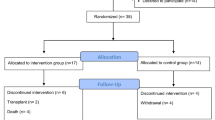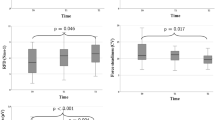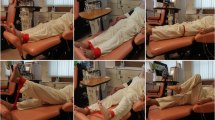Abstract
Aim
Skeletal muscle atrophy and dysfunction with associated weakness may involve the respiratory muscles of dialysis patients. We evaluated the effect of moderate-intensity exercise on lung function and respiratory muscle strength.
Methods
Fifty-nine patients (25 F, aged 65 ± 13 years) from two centers participating in the multicenter randomized clinical trial EXerCise Introduction To Enhance Performance in Dialysis (EXCITE) were studied. Subjects were randomized into a prescribed exercise group (E), wherein subjects performed two 10-min walking sessions every second day at an intensity below the self-selected speed, or a control group (C) with usual care. Physical performance was assessed by the 6-min walk test (6MWT). Patient lung function and respiratory muscle strength were evaluated by spirometry and maximal inspiratory pressure (MIP), respectively.
Results
Forty-two patients (14 F) completed the study. At baseline, the groups did not differ in any parameters. In total, 7 patients (4 in E; 3 in C) showed an obstructive pattern. The pulmonary function parameters were significantly correlated with 6MWT but not with any biochemical measurements. Group E safely performed the exercise program. At follow-up, the spirometry parameters did not change in either group. A deterioration of MIP (−7 %; p = 0.008) was observed in group C, but not in group E (+3.3 %, p = ns). In E, an increase of 6MWT was also found (+12 vs. 0 % in C; p = 0.038).
Conclusion
In dialysis patients, a minimal dose of structured exercise improved physical capacity and maintained a stable respiratory muscle function, in contrast to the control group where it worsened.


Similar content being viewed by others
References
Johansen KL, Shubert T, Doyle J, Soher B, Sakkas GK, Kent-Braun JA (2003) Muscle atrophy in patients receiving hemodialysis: effects on muscle strength, muscle quality, and physical function. Kidney Int 63:291–297
Palamidas AF, Gennimata SA, Karakontaki F, Kaltsakas G, Papantoniou I, Koutsoukou A, Milic-Emili J, Vlahakos DV, Koulouris NG (2014) Impact of hemodialysis on dyspnea and lung function in end stage kidney disease patients. Biomed Res Int 2014:212751
Bark H, Heimer D, Chaimovitz C, Mostoslovski M (1988) Effect of chronic renal failure on respiratory muscle strength. Respiration 54:153–161
Campistol JM (2002) Uremic myopathy. Kidney Int 62:1901–1913
Ikizler TA, Pupim LB, Brouillette JR, Levenhagen DK, Farmer K, Hakim RM, Flakoll PJ (2002) Hemodialysis stimulates muscle and whole body protein loss and alters substrate oxidation. Am J Physiol Endocrinol Metab 282:E107–E116
John SG, Sigrist MK, Taal MW, McIntyre CW (2013) Natural history of skeletal muscle mass changes in chronic kidney disease stage 4 and 5 patients: an observational study. PLoS One 8:e65372
Keith DS, Nichols GA, Gullion CM, Brown JB, Smith DH (2004) Longitudinal follow-up and outcomes among a population with chronic kidney disease in a large managed care organization. Arch Intern Med 164:659–663
Kovelis D, Pitta F, Probst VS, Peres CP, Delfino VD, Mocelin AJ, Brunetto AF (2008) Pulmonary function and respiratory muscle strength in chronic renal failure patients on hemodialysis. J Bras Pneumol 34:907–912
Karacan O, Tutal E, Colak T, Sezer S, Eyüboğlu FO, Haberal M (2006) Pulmonary function in renal transplant recipients and end-stage renal disease patients undergoing maintenance dialysis. Transplant Proc 38:396–400
Zifko U, Auinger M, Albrecht G, Kästenbauer T, Lahrmann H, Grisold W, Wanke T (1995) Phrenic neuropathy in chronic renal failure. Thorax 50:793–794
Silva VG, Amaral C, Monteiro MB, Nascimento DM, Boschetti JR (2011) Effects of inspiratory muscle training in hemodialysis patients. J. Bras Nefrol 33:62–68
Guleria S, Agarwal RK, Guleria R, Bhowmik D, Agarwal SK, Tiwari SC (2005) The effect of renal transplantation on pulmonary function and respiratory muscle strength in patients with end-stage renal disease. Transplant Proc 37:664–665
Rocha CB, Araújo S (2010) Evaluation of maximum respiratory pressures in chronic renal patients at the pre and post hemodialysis moment. J Bras Nefrol 32:105–111
Faria Rde S, Fernandes N, Lovisi JC, Reboredo Mde M, Marta MS, Pinheiro Bdo V, Bastos MG (2013) Pulmonary function and exercise tolerance are related to disease severity in pre-dialytic patients with chronic kidney disease: a cross-sectional study. BMC Nephrol 14:184
Pellizzaro CO, Thomé FS, Veronese FV (2013) Effect of peripheral and respiratory muscle training on the functional capacity of hemodialysis patients. Ren Fail 35:189–197
Teixeira CG, Duarte Mdo C, Prado CM, de Albuquerque EC, Andrade LB (2014) Impact of chronic kidney disease on quality of life, lung function, and functional capacity. J Pediatr (Rio J) 90:580–586
Aucella F, Battaglia Y, Bellizzi V et al (2015) Physical exercise programs in CKD: lights, shades and perspectives (corrected). J Nephrol 28:143–150 (Erratum in: J Nephrol 28:521)
Heiwe S, Jacobson SH (2014) Exercise training in adults with CKD: a systematic review and meta-analysis. Am J Kidney Dis 64:383–393
Mallamaci F, Manfredini F, Bolignano D et al., EXCITE Working Group (2014) A personalized, low-intensity, easy to implement, home exercise program improves physical performance in dialysis patients: the exercise introduction to enhance performance in dialysis (EXCITE) Trial. American Society of Nephrology 2014 Meeting, Philadelphia 11–16 Nov 2014 (FR-OR049)
Baggetta R, Bolignano D, Torino C, EXCITE Working Group et al (2014) Fitness for entering a simple exercise program and mortality: a study corollary to the exercise introduction to enhance performance in dialysis (EXCITE) trial. Kidney Blood Press Res 39:197–204
European Respiratory Society (2005) European respiratory monograph 31 Vol. 10: Lung function testing. Gosselink R, Stam (eds). doi:10.1183/1025448x.erm3105
ATS Committee on Proficiency Standards for Clinical Pulmonary Function Laboratories (2002) ATS statement: guidelines for the six-minute walk test. Am J Respir Crit Care Med 166:111–117
Segura-Ortí E, Martínez-Olmos FJ (2011) Test-retest reliability and minimal detectable change scores for sit-to-stand-to-sit tests, the six-minute walk test, the one-leg heel-rise test, and handgrip strength in people undergoing hemodialysis. Phys Ther 91:1244–1252
Manfredini F, Lamberti N, Malagoni AM, Felisatti M, Zuccalà A, Torino C, Tripepi G, Catizone L, Mallamaci F, Zoccali C (2015) The role of deconditioning in the end-stage renal disease myopathy: physical exercise improves altered resting muscle oxygen consumption. Am J Nephrol 41:329–336
Gómez-Fernández P, Sánchez Agudo L, Calatrava JM, Escuin F, Selgas R, Martínez ME, Montero A, Sánchez-Sicilia L (1984) Respiratory muscle weakness in uremic patients under continuous ambulatory peritoneal dialysis. Nephron 36:219–223
Pitta F, Brunetto AF, Padovani CR, Godoy I (2004) Effects of isolated cycle ergometer training on patients with moderate-to-severe chronic obstructive pulmonary disease. Respiration 71:477–483
Powers SK, Criswell D (1996) Adaptive strategies of respiratory muscles in response to endurance exercise. Med Sci Sports Exerc 28:1115–1122
O’Donnell DE, McGuire M, Samis L, Webb KA (1998) General exercise training improves ventilatory and peripheral muscle strength and endurance in chronic airflow limitation. Am J Respir Crit Care Med 157(5 Pt 1):1489–1497
Malagoni AM, Catizone L, Mandini S, Soffritti S, Manfredini R, Boari B, Russo G, Basaglia N, Zamboni P, Manfredini F (2008) Acute and long-term effects of an exercise program for dialysis patients prescribed in hospital and performed at home. J Nephrol 21:871–878
Bernardi E, Pomidori L, Bassal F, Contoli M, Cogo A (2015) Respiratory muscle training with normocapnic hyperpnea improves ventilatory pattern and thoracoabdominal coordination, and reduces oxygen desaturation during endurance exercise testing in COPD patients. Int J Chron Obstruct Pulmon Dis 10:1899–1906
Acknowledgments
This work was partly supported by an Italian government Grant from the Health Minister (Ricerca Finalizzata).
Author information
Authors and Affiliations
Corresponding author
Ethics declarations
Conflict of interest
The authors declare that they have no conflict of interest.
Ethical approval
All procedures performed in this study involving human participants were in accordance with the ethical standards of the institutional and/or national research committee and with the 1964 Helsinki declaration and its later amendments or comparable ethical standards.
Informed consent
Informed consent was obtained from all individual participants included in the study.
Rights and permissions
About this article
Cite this article
Pomidori, L., Lamberti, N., Malagoni, A.M. et al. Respiratory muscle impairment in dialysis patients: can minimal dose of exercise limit the damage? A Preliminary study in a sample of patients enrolled in the EXCITE trial. J Nephrol 29, 863–869 (2016). https://doi.org/10.1007/s40620-016-0325-2
Received:
Accepted:
Published:
Issue Date:
DOI: https://doi.org/10.1007/s40620-016-0325-2




